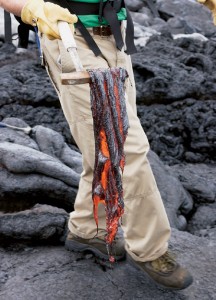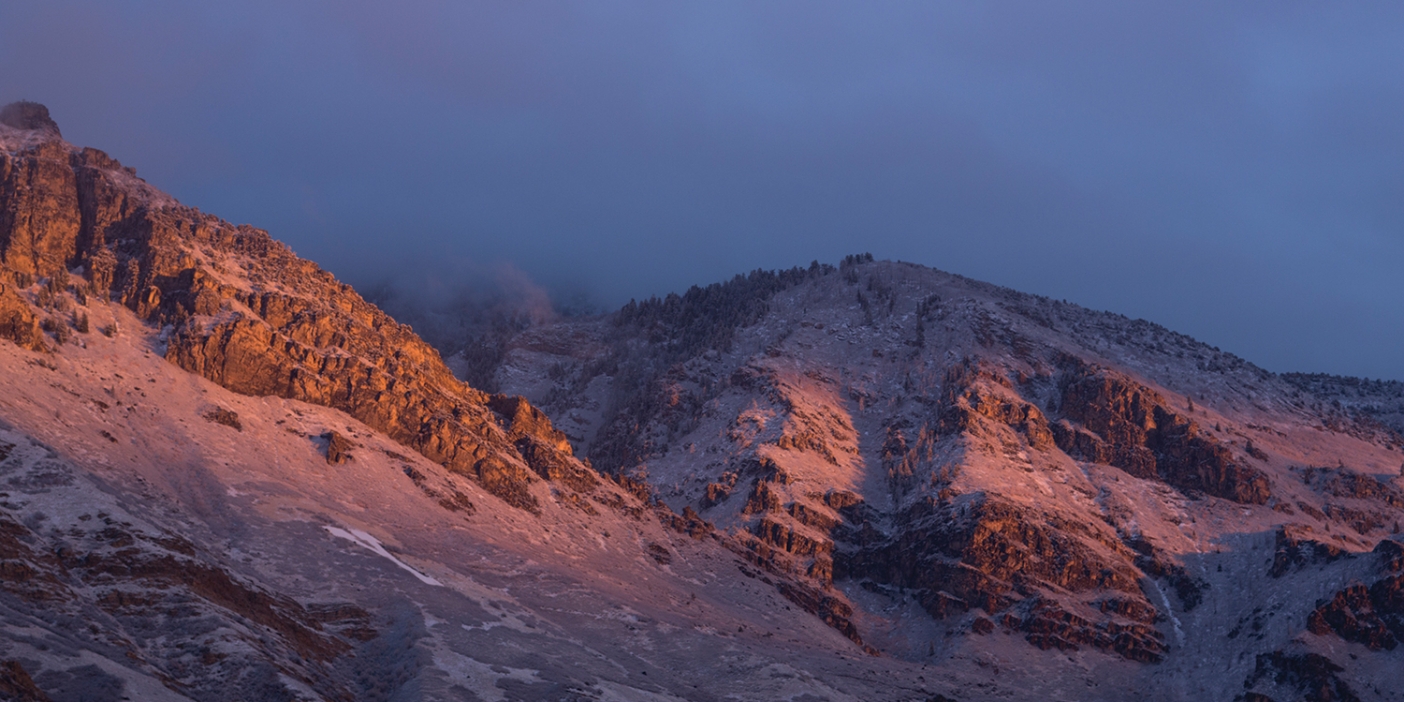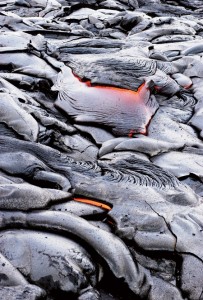
The unusual landscape and active lava flows created by Mount Kilauea in Hawaii Volcanoes National Park make the area a geologist’s paradise. BYU geology professor Jeffrey D. Keith, ’77, knows th land well and brings students here to study volcanic processes as they happen.
By Grant R. Madsen, ‘98
It’s 3:30 a.m., and wind howls through the lush foliage surrounding the Volcano House Hotel.
Comfortable in his bed, BYU geology professor Jeffrey D. Keith, ’77, awakens to the sound of possibility—a pause in the persistent rain that has prevented him and his students from finding and collecting fresh lava samples from Hawaii Volcanoes National Park.
Yesterday’s attempt was hampered by inclement weather, which produced so much steam that it was impossible to locate newborn rock.
Worried about the possibility of the trip being a bust, Keith climbs out of his warm bed and into wet hiking boots. Careful not to wake his wife, he slips from the room and descends to the dark parking lot. As his students sleep, Keith drives a rental car 20 minutes down a twisting road to the lava fields—a craggy and alien landscape straight out of a science-fiction film.
Made of barren, glass-crusted rock that crunches and crackles underfoot, the extensive lava fields are the product of Mount Kilauea, one of the world’s most active volcanoes.

Professor Keith discusses a rock sample with Stpephanie E. Ashley, ’05. Students collected samples from the lava fields as part of keith’s research aimed at understanding the formation of copper, silver, and gold deposits.
Standing on the fields’ edge, Keith spots the eerie red glow of active lava reflecting off thick cloud cover miles in the distance. He aligns the exact spot with the edge of a nearby U.S. Forest Service storage shed. Keith marks the dirt next to the paved road and makes the trip back to the comfort of his hotel room.
Over the course of his 12 years of research and teaching at BYU, Keith has brought more than 100 students, faculty, and alumni to examine lava flows and to sizzle the soles of their shoes on Hawaii’s lava fields. Here Keith conducts research and helps students do the same, all the while enhancing their educational experience.
“Students have seen pictures of lava flows in textbooks,” says Keith, who has published 17 scholarly papers about volcanic activity and ore deposits. “But it’s an entirely different experience to come here and see them being formed, to walk up close enough that they can feel the heat and see how those individual forms are made and how fast they move. I think that they’ll never look at things the same way again.”
But finding lava isn’t as easy as it sounds. In fact, yesterday it was impossible.
DAY 1: A RAIN-DRENCHED EXPEDITION
Rain hammered the group’s will on the first day of lava hunting. Ponchos failed and water dripped from hair and noses. Humidity and thick steam added to the general discomfort, as did the incessant rising and falling of their path over the black, rocky terrain.
Despite the physical challenges, not one of the students complained. They love the lava fields for what they are—a geologist’s paradise.
“This place is unbelievable,” said Matthew P. Harper, ’01, from Blackfoot, Idaho, who came on the trip to study mafic magmas related to his master’s thesis research. “There is so much to see here, so much to learn about.”
Like Keith, Harper is researching the processes of ore formation, particularly those that happen deep beneath the earth’s surface in certain kinds of magma chambers.
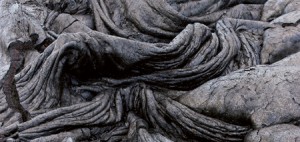
The lava fields contain varied designs of natural artwork. While some sections of the fields are smooth and rounded, others are textured with ropy, intricate folds of rock.
Buoyed by their enthusiasm for geology, the group members methodically made their way toward what Keith called a “shatter ring,” a geologic formation that recently appeared in the park. As they hiked, Keith pointed out occasional wisps of blue sulfur smoke produced by an active river of lava just a few feet below the crust, inevitably followed by the smell of rotten eggs.
When they arrived at the shatter ring, the rain stopped as if on cue. Keith explained that the doughnut-shaped formation of rocks stacked about 20 feet tall mysteriously appeared in the park. Geologists hypothesize that, much like an angry boil, pressure increased in an underground river of lava until small explosions cast the sharp-edged rocks into their circular shape.
“It was several big hiccups,” said Keith.

Standing on newborn land, graduate student William J. A. Stavast, ’00, gathers rocks for future study.
After lunch, the group tried to find the elusive lava flows. The rain held for a while, but the search did not become easier. Keith wandered off by himself through blankets of steam, eyes focused on the ground as he searched for an opening in the underground lava tubes. Soon, he called the group together and suggested they hike to the coast to see a lava tube that delivers red-hot magma into the ocean.
At the coast, the group stood on a cliff, looking down at the point of entry 100 feet below. Keith warned the students not to get too close to the edge.
“Theoretically, this whole piece of land could fall into the ocean,” he said impishly. Some of the students looked wide-eyed at each other. “But the chances of it happening today are small.”
No lava was actually visible. The tube delivers its payload under water, providing evidence of its existence in the form of an impressive, billowing plume of steam rising from the surface.
In the middle of Keith’s impromptu lecture on the process, the rain returned in spades.
Any drying that took place during the lunchtime reprieve was immediately reversed. The group huddled together, waiting, perhaps praying, for another break in the weather. Instead, the rain’s intensity increased exponentially. Sheets of water, blown sideways by the wind, hurled through the air.
Finally, Keith suggested abandoning the day’s quest and returning to the lodge.

BYU geology students trek through misty lava fields. Steam produced by rain on the fields made it impossible for the group to locate active lava flows during their first day’s seach.
LIVING LAVA RESEARCH
The expedition, coming on the heels of Thanksgiving break, included a mix of undergraduate and graduate students—nine in all—seeking information particularly valuable to mining companies, like Kennecott Utah Copper, which regularly profit from the volcanic activity of eons past.
“If we can understand the processes involved in the formation of these metal ore deposits, we can come up with better and more efficient means of exploration,” says Keith, who published a scholarly article on the topic early this year in the geology journal Mineralium Deposita.
In his research, funded by the National Science Foundation, Keith hypothesizes that sulfur and chlorine gases at the base of magma chambers rise to the surface of the magma, capturing and pooling metal as they go. Eventually, the ore and magma cool, awaiting discovery by the mining industry.
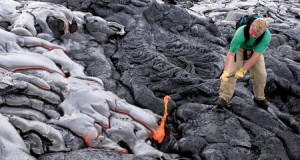
As graduate student Matthew P. Harper, ’01, pulls fresh lava from an active flow, the orange goo stretches like warm molasses. Harper came to hawaii to study magmas related to his master’s thesis research.
“The copper and gold deposits of Bingham Canyon (southwest of Salt Lake City) probably formed this way,” says Keith, explaining that mining companies exploring for copper, gold, and silver might be better off looking for evidence of iron-, sulfur-, and chlorine-rich magmas, as these could mark the areas where ore deposits might be formed. By sampling and analyzing fresh lava in the laboratory, he hopes to find further evidence of these gases on the surface of lava to support his hypothesis.
Donald A. Swanson, scientist-in-charge of the Hawaiian Volcano Observatory for the U.S. Geological Survey, says Keith is on the right track.
“This is the first time that these sorts of observations have been made, and they are very intriguing,” says Swanson. “There’s quite a lot of sulfur in the lava from Kilauea, and there is some chlorine, too. Both are soluble in water, so it’s necessary to gather the samples before they are rained on. Because we have fresh lava flows, this is certainly the right place to gather the kind of samples Dr. Keith needs for his research.”
LAVA HUNTING—TAKE TWO
The morning following Keith’s late-night excursion, students convene in the hotel’s cozy lobby wearing jackets still wet from the day before. A fire in the fireplace warms the uncharacteristically chill morning and helps a few students dry socks and boots.
Keith has not entered the lobby yet, and there is talk of whether or not the group will try to find active flows today. Despite the fact that the rain has commenced again, most in the group favor another attempt.
“We came here to find lava, and even though the weather isn’t going to cooperate we might as well try,” says graduate student William B. Harris, ’88. “It’s not like our clothes aren’t already wet.”
Keith arrives. Walking to the fireplace, he grabs a long, iron poker. Leaning against it, he tells the group about his nocturnal solo trip to the lava fields. The students, somewhat solemn to this point, are heartened by the news. Keith is confident that lava is in everyone’s future.
Because the big island of Hawaii is so geologically active, it’s one of the few places on Earth where Keith can bring students to study volcanic processes as they happen. A drive through the national park via the winding Chain of Craters Road provides the setting for an unconventional class lecture—students take in views of the vivid effects of the Kilauea volcano as they descend 3,700 feet from its crater to the Pacific Ocean. Along the way they pass lava tubes, steam vents, and craters, ending at an old lava flow that covers and blocks the paved road.
The shadeless lava fields offer a stark contrast to the beautiful flora that envelops the Volcano House Hotel. Some sections of the field are smooth and round, resembling burned loaves of bread smashed together in clusters. Others look like the rich, overturned soil of a freshly plowed field. Intricate designs of natural artwork are scattered throughout, as if some hand had patiently placed twisted ebony ropes one after the other or meticulously folded a thick, black cloth back and forth, setting it gently on the ground.
After a night’s sleep and Keith’s good news, the frustrations of yesterday are almost forgotten. The heavy rain is gone now. Only a light drizzle remains.
Parking their vehicles at the edge of the lava fields, the group quickly unloads gear for the task ahead. Gloves, canteens, rock hammers, global-positioning instruments, and distilled water are situated into backpacks.
Keith goes to the edge of the road and finds his orienteering mark. He aligns it with the edge of the shed and uses the hotel’s iron poker, which doubles as his walking stick, to point to the area where he saw active flows the night before. The spot, Keith estimates, is about six miles away.
Without the incessant rainfall, the going, at first, is much easier. After a few minutes the rain stops altogether and the clouds disperse. However, this poses a new problem—the temperature and humidity rise to nearly unbearable levels. Students stop frequently to wipe sweat from their brows or to drink deeply from water bottles.
Frequently, students stoop to study a rock. Sophomore Stephanie E. Ashley, ’05, a rock in one hand and a pick in the other, shows Keith some strange white formations clinging to a piece of black rock.
Keith theorizes that the white specks are some kind of salt and sulfate accumulation. He removes his glove and unexpectedly pops some into his mouth.
“Yep,” he says. “That is salty.”
Keith motions to William J. A. Stavast, ’00, a graduate student from Orem, Utah, and suggests he gather laboratory samples of some of the white rock. Placing a small amount in a plastic bag, Stavast pulls out a global-positioning instrument to mark precisely where he found the sample.
“We want to see how close this area is to the vent, which is where the lava comes out. The further away from the vent, the fewer sulfides (sulfur-based minerals) should be present,” says Stavast. “Sulfide is what captures precious metals as it rises through the magma. If we aren’t finding sulfides in these rocks that are far away from the vent, we think the copper, silver, and gold will be dispersed as well.”
They resume their journey. Soon, they approach a looming, black wall of rock—a 75-foot ridge covered by thick, ropy lava. The group cautiously scales a portion of the wall made of loose rocks coated with a thin sheen of glass.
About two miles later, everyone notices a drastic temperature change. The ground is warm to the touch. Steam and sulfur pour from jagged cracks in the crust.
Keith explains that lava flows through hollow chambers beneath them. It’s probable that the group has been walking over similar chambers, now void of flowing lava, for miles. This revelation prompts a student to ask about the possibility of falling through the crust.
“Park geologists drive large trucks over some of these areas,” says Keith. “So unless you had a really big breakfast, I think we’re fairly safe.”
FROM HAWAII, WITH LAVA
Minutes later, a student who has hiked ahead returns with excitement in his voice. He has seen them—lava flows hissing and crackling as they creep toward the coast across older, solidified flows.
As the group approaches, the heat is nearly unbearable; students put on long-sleeved shirts to protect their arms.
Keith cautiously moves toward one of the flows and uses the borrowed iron poker to punch through the thin, silvery skin that forms on lava as it is exposed to the air. Twisting the poker around, he gradually lifts his prize for the students to see. Fresh lava oozes out of the newly formed hole. The tip of the poker is covered in orange goo that stretches from the hole like warm molasses.
Immediately, the students follow suit, thrusting the iron claws of their hammers into the river of red-hot lava. They pull back samples of molten rock that stretch through the air like soft taffy and form a silvery coating of their own.
The intense heat forces the students to shield their faces with gloved hands and then rapidly flee the proximity of the flow to shake the lava from their hammers to the ground. In moments, it takes on a charcoal-like hue and cools to about 300 to 400 degrees Fahrenheit, far below its original 2,000-plus degree temperature.
“Nothing compares to this,” says Harper, red faced from the heat. “You can’t sit in a classroom long enough or watch enough videos to realize the magnitude of what is happening out here—it’s amazing to get right up and see rock flow like syrup.”
After the lava has cooled sufficiently, the students snap off small chunks and place them into plastic bags and containers. The samples will be studied later at BYUunder an electron microprobe, a device that will determine their chemical composition. Other samples are inserted into vials containing distilled water, where salts and minerals in the lava dissolve for laboratory study.
Stavast will do most of the laboratory analysis for Keith. The graduate student has studied similar rocks from deposits in Bingham Canyon.
“Hopefully, we will be able to make a model that could be used elsewhere to tip us off to the presence of a nearby ore body,” he says.
After the business of gathering samples is over, the group takes time to have fun with the lava. They take turns to see who can retrieve the biggest sample. A tuna fish can, a remnant from lunch, is recycled in a spontaneous science experiment. Loose change is melted into other lava samples for instant souvenirs.
Although he has been here before, Keith shares his students’ enthusiasm.
“It’s really a spiritual experience to see new land being created,” he says. “I’m in awe. I could stand here and watch this all day.”
Unfortunately, that’s not possible. After an hour, the group decides it’s time to head back to the lodge.
Before leaving the flows, Amber K. Syme, ’01, a senior from Orem, takes a moment to reflect on her geology studies. “This is the culmination of all the classes that I’ve taken to this point,” she says.”You start out learning about the basics of geology and then one day you come to the birth of land. It’s pretty incredible. It makes me have a greater appreciation for the processes I’ve learned about in class already.”
As they return to the cars, the students talk about their experiences. Harris sums up the group’s general sentiment of the trek over the lava fields.
“Yesterday’s rain was a major pain, but finding the lava flows today made it all worth it.”
Grant Madsen is a media relations manager for BYU‘s University Communications.
web: Go to this BYU Magazine extra to see video clips of BYU students harvesting lava.







